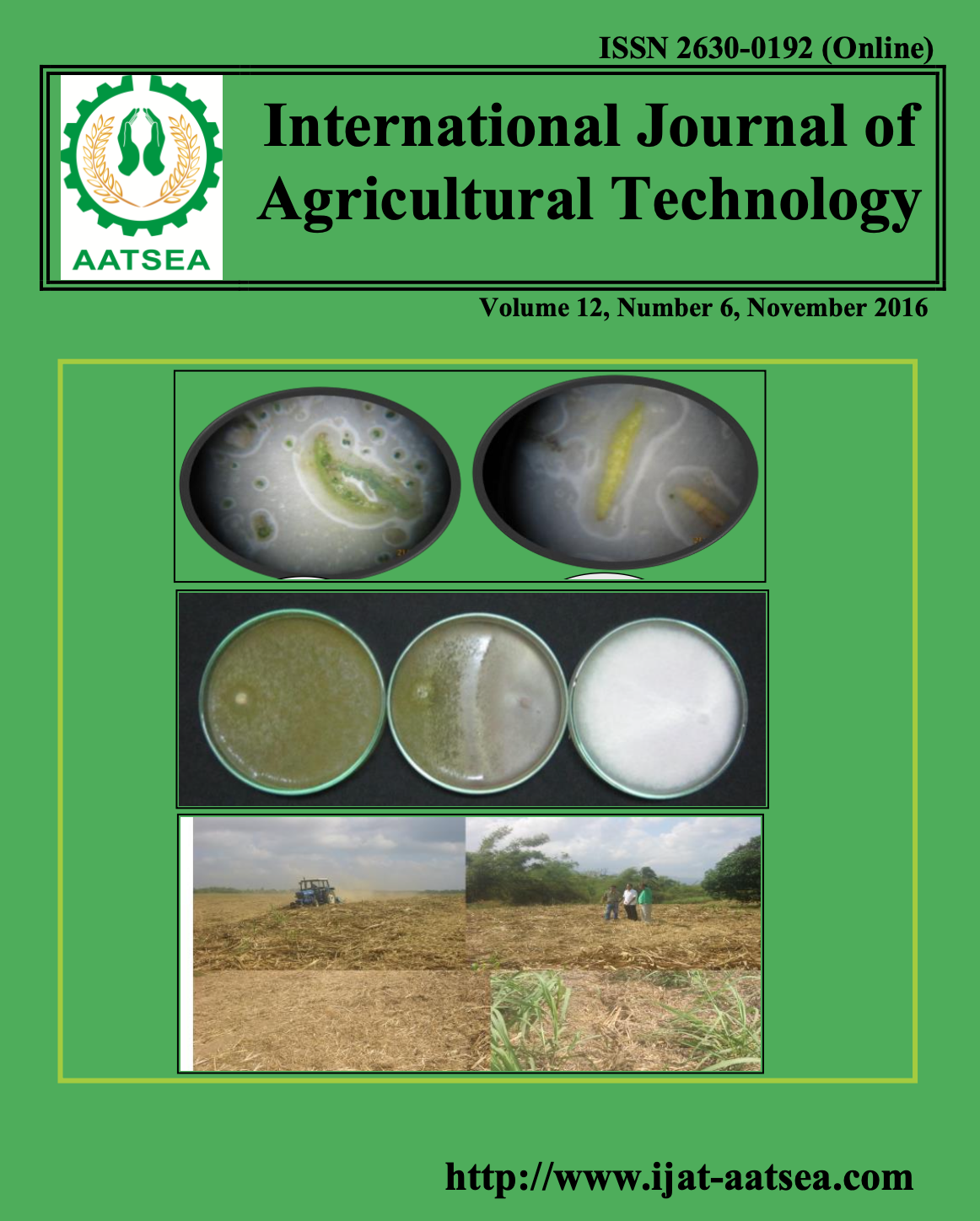Study on DNA degradation by natural herbicide from Tagetes erecta L. during Amaranthus spp seed germination
Main Article Content
Abstract
Marigold leaf (Tagetes erecta L.) was extracted with 75% ethanol in water and evaporated ethanol to obtain crude ethanol extract. The crude ethanol fraction was diluted with distilled water, resulting in aqueous solution which was hydrolized by acidified to pH 3 with 6 N HCl. The filtrate was extracted with ethyl acetate three times. The ethyl acetate solutions were combined, dried over anhydrous MgSO4, and then evaporated to obtain the ethyl acetate soluble hydrolyzed fraction (Hy fraction). The Hy fraction was mixed with adjuvant at the ratio of 30: 70 to give of 30% active ingredient (a.i.) in soluble concentrate formulation (SC). In order to investigate the effects of SC formulation concentrations from T. erecta that is lower than concentrations that completely inhibited seed germination and seedling growth of Amaranthus tricolor L. (2500 ppm), Amaranthus gracilis Desf. and Amaranthus spinosus L. (1000 ppm) and obtain samples (leaf and stem) for DNA extraction, a dose of concentration application from 100 to 1000 ppm of T. erecta leaf extract in SC formulation was bioassayed on germination, seedling growth on 3 species of amaranth. The results showed that at lower concentration of T. erecta leaf extract (less than 1000 ppm) still contains inhibition on germination and seedling growth. Thus, next experiment was studied to obtain these samples and extract its DNA genomic to understand molecular mechanisms of allelopathic potential on DNA degradation of Amaranthus spp. The results indicated that DNA extracted from 3 Amaranthus species treated with leaf extract in SC formulation from T. erecta by concentration of 100 - 1000 ppm according to each species showed different genomic DNA degradation. Genomic DNA extracted from A. spinosus showed the most sensitively degraded, followed by A. gracilis and A. tricolor. Hence the use of T. erecta leaf extract as a potential natural herbicide for weed control might be possible.
Article Details

This work is licensed under a Creative Commons Attribution-NonCommercial-NoDerivatives 4.0 International License.
References
Belz, R. G. (2007). Allelopathy in crop/ weed interactions - an update. Pest Management Science 63:308-26.
Graeber, K., Nakabayashi, K., Miatton, E., Leubner-Metzger, G. and Soppe, W. J. (2012). Molecular mechanisms of seed dormancy. Plant Cell Environment 35:1769-1786.
Ito, J. and Hiroo, F. (2002). ZEN1 is a key Eenzyme in the degradation of nuclear DNA during programmed cell death of tracheary elements. The Plant Cell 14:3201-3211.
Laosinwattana, C., Boonleom, C., Teerarak, M., Thitavasanta, S. and Charoenying, P. (2010). Potential allelopathic effects of Suregada multiflorum and the influence of soil type on its residue’s efficacy. Weed Biology Management 10:153-159.
MariaTeresa, C., John, P., Elisabeth, P. and Tran Van, V. (2003). Degradation and transformability of DNA from transgenic leaves. Application Environment Microbiology 69:673-678.
McDonald, M. B. (2006). Physiology of seed germination. Seed biology program department of horticulture and crop science. The Ohio State University Columbus 43210-1086.
Meksawat, S. and Pornprom, T. (2010). Allelopathic effect of itchgrass (Rottboellia cochinchinensis) on seed germination and plant growth. Weed Biology Management 10:16-24.
Murphy, T. R. (1999). Turfgrass herbicide mode of action and environmental fate. The University of Georgia. College of Agriculture and Environmental Sciences.
Nonogaki, H. (2006). Seed Germination - The biochemical and molecular mechanisms. Breeding Science 56:93-105.
Olabiyi, T. I. and Oyedunmade, E. E. A. (2007). Marigold (Tagetes erecta L.) as interplant with cowpea for the control of nematode pests. African Crop Science Conference Proceedings 8:1075-1078.
Wichittrakarn, P., Changsawake, K., Teerarak, M., Charoenying, P. and Laosinwattana, C. (2012). Partially separation of allelochemicals from marigold leaf extract. The Proceeding of 10th International Symposium on Biocontrol and Biotechnology 55:77-83.


